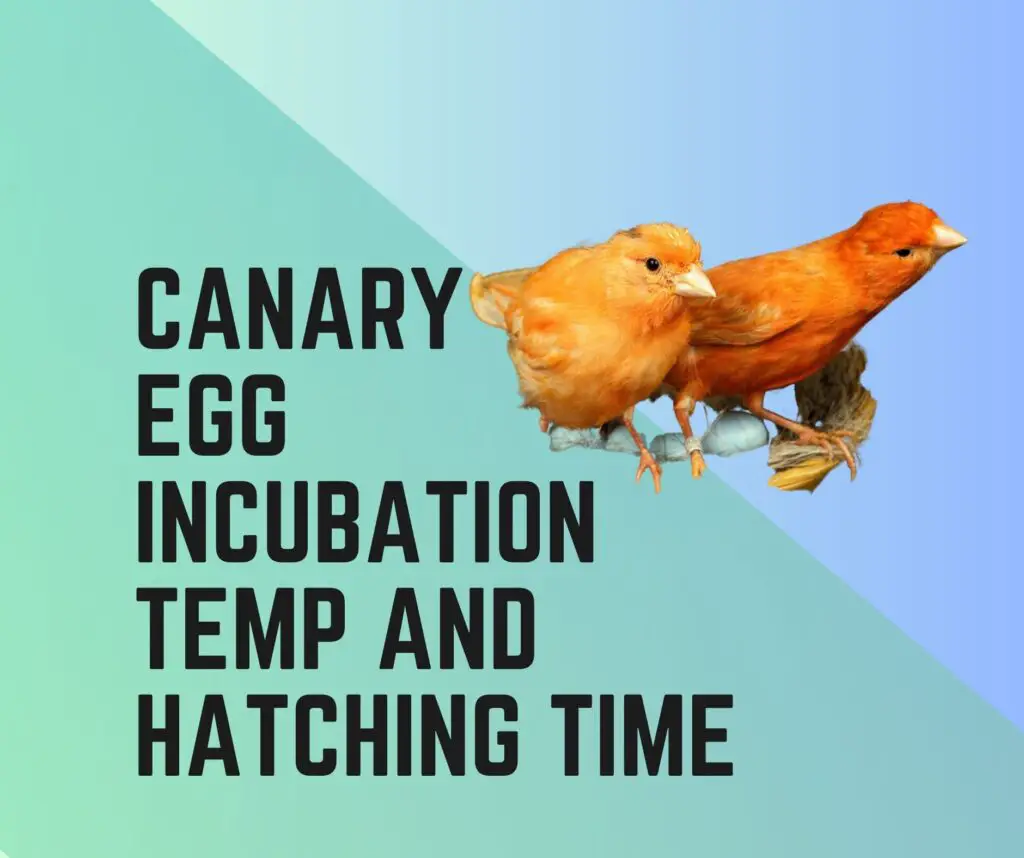Ever thought about how those little eggs turn into cheerful chirpers? If you are wondering right now, then join us as we dive into the captivating world of canary eggs.
This article/ comprehensive guide is all about “Canary Egg Incubation Temperature And Hatching Time”. While the topic may seem complex to many, we strive to keep it simple and chatty so that the learning process becomes easy. From keeping tabs on the heat to catching those cute hatching cues, the article has got it all covered.
So without any further ado, let’s get straight into the discussion. Walking into the natural wonder that’s canary egg incubation.
- What is the Incubation Temperature?
- But why does maintaining the right Incubation Temperature so important?
- What is the recommended temperature range for canary egg incubation?
- How does temperature affect the development of the embryos inside Canary eggs?
- How to monitor and regulate the temperature during incubation?
- How long does it typically take for canary eggs to hatch?
- Are there variations in hatching time (If Yes), and Why?
- Are there factors beyond the temperature that affect hatching time?
- How do genetics and egg health impact the hatching process?
- What physical changes in the eggs of Canaries indicate that hatching is about to occur?
- Common mistakes people often make when incubating canary eggs?
- Bottom Line…
What is the Incubation Temperature?
Incubation temperature is like a cosy nest for canary eggs that sets the stage for the miracle of birth. As a thumb rule, Incubation temperature (regardless of whom you are implying) should be not too hot and not too cold but just right. Maintaining the perfect temperature is like a warm embrace for the growing embryos inside those eggs.
But why does maintaining the right Incubation Temperature so important?
Incubation temperature is nature’s thermostat. With the right temperature, the magical transformation from egg to hatchling kickstarts. Incubation temperature too low can slow down the egg/embryo development.
Whereas, Incubation temperature too high can damage it literally. With not so right Incubation temperature, the embryos might not form properly, leading to failures and disappointments.
Just like anything living, eggs need that perfect balance to thrive. It’s a small adjustment that holds the potential for big rewards.
What is the recommended temperature range for canary egg incubation?
The ideal Incubation Temperature for Canary Eggs is between 98.6°F (37°C) and 100°F (37.8°C). Please Note that the embryo temperature inside the egg can be different.
How does temperature affect the development of the embryos inside Canary eggs?
Temperature is the architect of embryo development; come, let’s break it down plainly.
The ideal Incubation Temperature for Canary Eggs that makes the best studio for growth is When it’s around 37.5°C to 37.8°C. At this temperature, enzymes, the cellular workers, function optimally. They build organs, feathers, and beaks, bringing Canary step by step into life.
However, as the temperature goes haywire, it impacts the Canary building process. That happens when the Incubation temperature is either too high or low.
Therefore, in a nutshell, maintaining the correct temperature means giving the embryos the best shot at becoming healthy hatchlings.
How to monitor and regulate the temperature during incubation?
Keeping tabs on the temperature during canary egg incubation is important. This task of being watchful does include some knowledge and focus. Here’s all that you will need to keep a check upon:
- Get a reliable thermometer designed for incubators.
- Place the thermometer at egg height and check the temperature. Remember consistency is the key; thus, check the temperature a few times a day.
- Simultaneously keep on cross-checking the thermometer’s accuracy as well, often to avoid any false readings.
- If the temperature strays, adjust the incubator settings. Also, Keep the incubator in a room with a stable temperature.
- However, resist the urge to open the incubator too often since it will let the warmth escape and the temperature fluctuate.
- Record the Journey: Keep a log of temperature readings, and the key is to ensure “Not too hot, Not too cold”.
- Some easy methods to adjust the temperature (if it deviates from the ideal range)
- The temperature during incubation can go off track, but there are ways to fix it. For instance:
- Gently cover the egg using a cosy blanket if it is too cool.
- Adjust the incubator’s position in the room, closer or away from the heater, if it is too chilly or too warm.
- Fine-tune the incubator’s controls.
- Place a warm water bottle near the eggs if it’s too chilly.
- If your room’s temperature shifts, so might the incubator’s; thus, monitor both.
- Always have a backup incubator on hand.
- If everything fails, consult the experts.
Please Note: Gradual adjustments are better than sudden ones. Instead of flipping the switch, it is about turning the dial slowly around.
How long does it typically take for canary eggs to hatch?
Patience is the name, especially concerning the time of canary eggs hatching.
On average, from the moment Canary eggs are laid, it takes about 13 to 14 days until the exciting crack of hatching begins. However, since nature has variants and thus some eggs pop open a little earlier or later, not to be surprised.
Canary eggs have their own schedule, too; it is simply the countdown of Mother Nature.
Are there variations in hatching time (If Yes), and Why?
Absolutely, there can be variations in hatching time, much like there are with human pregnancy and birth.
Here are some of the reasons explaining the same:
- Since not all Canary eggs are laid on the same day, ones laid earlier might hatch before the fresher ones.
- If the temperature fluctuates, eggs’ development will speed up or slow down. It is the same as baking in an oven with slightly different settings.
- Some Canary chicks might develop a bit faster due to their genetic makeup.
- Healthy eggs tend to hatch on time, but the ones that aren’t up to par may take longer.
- Some mother canaries might start incubating as soon as the first egg is laid, while others wait until a few eggs are collected.
- Upon using an incubator, slight variations in conditions can influence when the eggs hatch.
Are there factors beyond the temperature that affect hatching time?
Absolutely, the hatching time isn’t solely determined by temperature. It includes multiple influences, for instance:
- Humidity: Just like temperature, too little or too much moisture can impact the hatching time for Canary eggs.
- Egg Turning: In nature, birds subtly rotate their eggs to ensure even heat distribution. Thus in captivity with an incubator, replicating this turning can influence hatching time.
- Egg Handling: Too much handling of egg results in internal contents shifting, thus affecting hatching time.
- Parental Incubation: If canary parents are responsible for incubating, their behaviours can influence hatching time.
- Egg Quality: The quality of the eggs matters and influences the hatching time.
- Environmental Factors: Noise, vibrations, and other external factors can influence stress levels, thus affecting the hatching time.
- Predator Presence: If there’s a perceived threat nearby, Canaries might delay hatching until it’s safer.
How do genetics and egg health impact the hatching process?
The genetic makeup of Canaries is influential upon the incubation period and overall egg development speed. Some Canaries (in their family) might have a history of hatching a bit faster, while others take their time.
Similarly, the egg’s health also influences how long or quick it will take the egg to hatch. Factors like maternal health, environmental conditions and nutrient availability impact the quality of egg forming.
Healthy genetics ensure that everything develops as it should. It impacts the Shell Strength making it strong and well-crafted due to good genetics and proper nutrition. A stronger eggshell protects the embryo better and aids in a successful hatch.
Further, the yolk is like a starter pack for the developing chick. If it’s rich in nutrients due to a well-nourished mother, it gives the chick a good head start.
What physical changes in the eggs of Canaries indicate that hatching is about to occur?
Nature has its ways of signalling the ultimate time of hatching. When it’s showtime, you might notice a few physical changes in canary eggs. Some hints that alert the arrival of those fluffy hatchlings include:
- Pip Marks, or the tiny cracks on the eggshell. These marks are the sign that the chick is starting to peck its way out.
- If you gently tap the egg or hold it close to your ear, you might hear faint peeps or feel slight movements.
- Mama canaries often rotate their eggs to help with hatching. If you notice eggs shifting around or turning on their own, it is almost time.
- If the Canary eggshell might appear slightly cracked or dented, it is almost time.
- Sometimes, the Canary eggshell darkens a bit as hatching nears.
- As the chick gets ready to break free, you might hear muffled peeping sounds from inside the egg.
- The chick might start chipping away at the eggshell, creating small holes.
Common mistakes people often make when incubating canary eggs?
Incubating canary eggs can be a delicate art, and here are some common mistakes to watch out for:
- Temperature Extremes and Temperature Fluctuations. The cosy range of 37.5 to 37.8°C is your goal.
- Incorrect Humidity (too much or too little moisture) in the air can affect egg health and development.
- Forgetting to turn eggs regularly can lead to uneven development and even sticking to the shell. However, turning around a lot may lead to a negative impact again.
- Rough Handling, including bumping, shaking, or dropping the Canary eggs, can harm the developing embryos.
- Delayed collection of eggs can lead to uneven hatching; thus, it is important to collect them as soon as the bird lays.
- Inadequate Ventilation and stagnant air can result in reduced oxygen levels and mold growth in the egg.
- Opening the Incubator Too Often disrupts the temperature and humidity levels, affecting embryo development.
- Lack of monitoring can lead to potential unnoticed issues.
- Not seeking guidance from experienced breeders or reliable sources can lead to avoidable mistakes.
- Lastly, Impatience is the biggest mistake since Hatching is a waiting game.
Bottom Line…
Overall, in the world of Canary Egg Incubation, the delicate balance of things around brings success. Taking care of temperature and humidity and ensuring proper egg health can bring good results.
Also, egg hatching is nature’s rhythm and thus requires patience and understanding.

Hi, There and Welcome to BirdsNews.com, is here to help you learn and care about pet birds. and this blog is a journal of everything I’ve learned.








